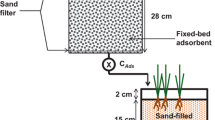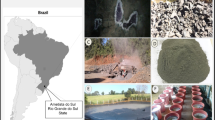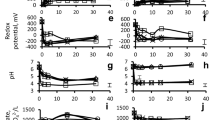Abstract
The metal removal and neutralization capacities of digested sewage sludges from municipal wastewater treatment plants, cattle slurry (liquid manure), and Biofert granules (dried granular anaerobic sludge) were compared under batch conditions using synthetic AMD (pH 2.8) containing high concentrations of Al, Cu, Fe, Mn, Pb, and Zn (100, 15, 270, 15, 2, and 30 mg/L, respectively). The effects of contact time and solids concentration were examined. Metal removal was variable for all materials. Contact time had a significant effect, with total removal often increasing over the experimental time interval (i.e. 30 min to 24 h). Removal efficiency (%) was generally highest for Cu, Pb, and Al, while Mn and Zn were the least removed. Cattle slurry was the best material for metal removal, with the following maximum removals at a solids concentration of 12.9 g/L: Cu >98 %, Al >98 %, Fe >60 %, Mn >18 %, Pb >96 %, and Zn >60 %. Metal removal using digested sewage sludge reached 88 % for Al, 98 % for Cu, 94 % for Pb, and 30 % for Zn. Neutralization was complete within 30 min after AMD was mixed with digested sludges or cattle slurry, with the pH reaching a maximum of 5.5 with the slurry. In contrast, neutralization by the Biofert granules only reached equilibrium after 300 min, and pH remained <4.0 except at high solids concentrations. It appears that recycled waste-derived organic materials can neutralize AMD and remove dissolved metals by adsorption and precipitation, creating a more treatable waste stream or one that could be discharged directly to surface water. Potential methods of safe disposal of metal-enriched organic materials are discussed.
Zusammenfassung
Die Metallfällungs- und Neutralisationskapazität von getrockneten Faul-/Klärschlämmen aus kommunalen Kläranlagen, Rindergülle sowie organischen Düngergranulat (Biofert) wird in Batchexperimenten unter Verwendung von synthetischen AMD mit hohen Metallkonzentrationen (Al: 100 mg/l, Cu: 15 mg/l, Fe: 270 mg/l, Mn: 15, Pb: 2 mg/l, Zn: 30 mg/L) verglichen. Bei der Untersuchung der Aufenthaltszeit sowie der jeweilige Gesamtkonzentration zeigt sich, dass die Fällungseigenschaften je nach Metall variabel sind. Mit steigenden Kontaktzeiten (30 min bis 24 h) nimmt der Metallentzug aus der Lösung in der Regel zu. Die höchsten Entzugsraten wurden bei Cu, Pb und Al registriert, während Mn und Zn zu geringeren Teilen aus der Lösung entfernt wurden. Rindergülle zeigte die wirksamsten Entzugseigenschaften für die betrachteten Metalle. Bei 12,9 g/l Gesamtkonzentration wurden maximale Entzungsraten (Cu >98 %, Al >98 %, Fe >60 %, Mn >18 %, Pb >96 %, Zn >60 %) erreicht. Bei getrockneten Faul-/Klärschlamm wurden der Lösung 88 % Al, 98 % Cu, 94 % Pb und 30 % Zn entzogen. Bereits 30 min nach der Mischung mit Schlamm bzw. Rindergülle hatte die Lösung eher neutrale Eigenschaften. In Gülle betrug der pH-Wert maximal 5,5. Im Gegensatz dazu wurde ein pH-Wert Erhöhung bei organischen Düngergranulat (Biofert) erst nach 300 min festgestellt, wobei der pH-Wert weiterhin <4 betrug und die Metallkonzentration hoch blieb. Insgesamt ist aufgearbeitetes organisches Material in der Lage, AMD zu neutralisieren und gelöste Metalle zu adsorbieren und zu fällen. Hierdurch können die Eigenschaften der Grubenwässer ggf. soweit verbessert werden, dass sie direkt in Vorfluter abgegeben werden können. Zusätzlich werden Möglichkeiten diskutiert, das durch Metalle angereicherte organische Material sicher zu entsorgen.
Resumen
Las capacidades de neutralización y de remoción de metales de lodos digeridos en plantas de tratamiento de aguas residuales municipales (WWTPs), lodos de actividades ganaderas (estiércol líquido) y gránulos Biofert (lodo anaeróbico seco en gránulos) fueron comparados, en condiciones batch, usando AMD sintético (pH 2,8) conteniendo altas concentraciones de Al, Cu, Fe, Mn, Pb y Zn (100, 15, 270, 15, 2 y 30 mg/L, respectivamente). Se analizaron los efectos del tiempo de contacto y de la concentración de sólidos. La remoción de metales fue variable para todos los materiales. El tiempo de contacto tuvo un efecto significativo, con una remoción total que se incrementaba con el intervalo de tiempo experimental (por ejemplo, 30 minutos a 24 h). La eficiencia de la remoción (%) fue generalmente máxima para Cu, Pb y Al, mientras que Mn y Zn fueron los menos removidos. El lodo de actividades ganaderas fue el mejor material para la remoción de metales, con las siguientes remociones máximas a 12,9 g/L de concentración de sólidos: Cu >98 %, Al >98 %, Fe >60 %, Mn >18 %, Pb >96 % y Zn >60 %. La remoción de metales usando lodos digeridos alcanzó el 88 % para Al, 98 % para Cu, 94 % para Pb y 30 % para Zn. La neutralización fue complete dentro de los 30 min después de que el AMD se mezcló con lodos digeridos o lodos de actividades ganaderas, con el pH alcanzando un máximo de 5,5 con el lodo líquido. En contraste, la neutralización por los gránulos Biofert sólo alcanzó el equilibrio después de 300 min y el pH se mantuvo por debajo de 4,0 excepto a altas concentraciones de sólidos. Se ha mostrado que los materiales orgánicos derivados del reciclado de residuos puede neutralizar AMD y remover los metales disueltos por adsorción y precipitación, creando un flujo de residuos más tratable o uno que pudiera ser descargado directamente a aguas superficiales. Se discuten los potenciales metales de disposición segura de materiales orgánicos enriquecidos con metales.
抽象
用pH值为2.8的人工合成酸性矿井废水(Al、Cu、Fe、Mn、Pb和Zn离子浓度分别为100、 15、270、15、2和30 mg/L) 进行批次试验,对比、评价城市污水处理厂(MWTP)的溶解污泥、液体牲畜粪肥和干燥粒状厌氧污泥三类有机材料的酸中和与重金属离子去除能力。接触时间和固体浓度明显影响三类有机材料的去除效果。金属离子去除率随三类试验材料不同而变化。离子去除率受接触时间影响显著,随试验时间间隔增长(30分钟至24小时)而增大。Cu、Pb和Al的去除率最高,而Mn和Zn的去除率最低。液体牲畜粪肥去除金属离子效果最好;当其固体浓度为12.9 g/L时,各金属离子的去除率分别为Cu >98 %、Al >98 %、Fe >60 %、Mn >18 %、Pb >96 %和Zn >60 %。MWTP溶解污泥去除Al、Cu、Pb和Zn的效率分别为88 %、98 %、94 %和30 %。AMD与溶解污泥或牲畜粪肥混合后半小时,AMD溶液的中和过程即可完成,并使pH值增致5.5。然而,干燥粒状厌氧污泥需要300分钟才能使AMD达到中和平衡;而且,如果不提高固体浓度,AMD溶液pH值将始终低于4。试验研究说明,多种废物中的有机材料能够有效中和AMD酸性、去除AMD金属离子(吸附作用和沉淀作用),使AMD更易于处理甚至能够直接排入地表水体。文章进一步讨论了含金属有机材料的AMD安全处理方法。







Similar content being viewed by others
References
Acheampong MA, Meulepas RJW, Lens PNL (2010) Removal of heavy metals and cyanide from gold mine wastewater. J Chem Technol Biotechnol 85:590–613
Alibhai KRK, Mehotra I, Forster CF (1985) Heavy metal binding to digested sludge. Water Res 19(12):1483–1488
Álvarez EA, Mochón MC, Sánchez JCJ, Rodríguez MT (2002) Heavy metal extractable forms in sludge from wastewater treatment plants. Chemosphere 47:765–775
Antoniadis V, Alloway BJ (2002) The role of dissolved organic carbon in the mobility of Cd, Ni and Zn in sewage sludge-amended soils. Environ Pollut Ser A 117(3):515–521
APHA, AWWA, WEF (2005) Standard methods for the examination of water and wastewater, 21st edn. American Public Health Assoc, Washington, DC
Artola A, Balaguer MD, Rigola M (1997) Heavy metal binding to anaerobic sludge. Water Res 31(5):997–1004
Artola A, Martin M, Balaguer M, Rigola M (2000) Isotherm model analysis for the adsorption of Cd(II), Cu(II), Ni(II), and Zn(II) on anaerobically digested sludge. J Colloid Interface Sci 232:64–70
Atkinson BW, Bux F, Kasan HC (1998) Considerations for application of biosorption technology to remediate metal-contaminated industrial effluents. Water SA 24(2):129–136
Bamforth SM, Manning DAC, Singleton I, Younger PL, Johnson KL (2006) Manganese removal from mine waters—investigating the occurrence and importance of manganese carbonates. Appl Geochem 21:1274–1287
Bhatnagar A, Sillanpää M (2010) Utilization of agro-industrial and municipal waste materials as potential adsorbents for water treatment—a review. Chem Eng J (Amsterdam, Neth) 157:277–296
Blais JF, Tyagi RD, Auclair JC (1993) Bioleaching of metals from sewage sludge: microorganisms and growth kinetics. Water Res 27(1):101–110
Brennan RB, Fenton O, Grant J, Healy MG (2011) Impact of chemical amendment of dairy cattle slurry on phosphorus, suspended sediment and metal loss to runoff from a grassland soil. Sci Total Environ 409(23):5111–5118
Burgos WD, Borch T, Troyer LD, Luan F, Larson LN, Brown JF, Lambson J, Shimizu M (2012) Schwertmannite and Fe oxides formed by biological low-pH Fe(II) oxidation versus abiotic neutralization: impact on trace metal sequesterization. Geochim Cosmochim Acta 76:29–44
Caravelli AH, Contreras EM, Zaritzky NE (2010) Phosphorous removal in batch systems using ferric chloride in the presence of activated sludges. J Hazard Mater 177:199–208
Çeçen F, Semerci N, Geyik A (2010) Inhibition of respiration and distribution of Cd, Pb, Hg, Ag and Cr species in a nitrifying sludge. J Hazard Mater 178(1–3):619–627
Chang WC, Hsu GS, Chiang SM, Su MC (2006) Heavy metal removal from aqueous solution by wasted biomass from a combined AS-biofilm process. Bioresour Technol 97:1503–1508
Chang WC, Hsu CH, Chiang SM, Su MC (2007) Equilibrium and kinetics of metal biosorption by sludge from a biological nutrient removal system. Environ Technol 28(4):453–462
DoELG (2008) Codes of good practice for the use of biosolids in agriculture: guidelines for farmers. Department of the Environment and Local Government, Dublin, Ireland. http://www.environ.ie/en/Publications/Environment/Water/FileDownLoad,17228,en.pdf. Accessed 1 Apr 2012
Demirbas A (2008) Heavy metal adsorption onto agro-based waste materials: a review. J Hazard Mater 157:220–229
Dewil R, Baeyens J, Appels L (2007) Enhancing the use of waste activated sludge as bio-fuel though selectively reducing its heavy metal content. J Hazard Mater 144:703–707
Evangelou VP (1998) Environmental soil and water chemistry: principles and applications. Wiley, NYC, NY
Febrianto J, Kosasih AN, Sunarso J, Ju YH, Indraswati N, Ismadji S (2009) Equilibrium and kinetic studies in adsorption of heavy metals using biosorbent: a summary of recent studies. J Hazard Mater 162(2–3):616–645
Fletcher P, Beckett PHT (1987a) The chemistry of heavy metals in digested sewage sludge—I. Copper(II) complexation with soluble organic matter. Water Res 21(10):1153–1161
Fletcher P, Beckett PHT (1987b) The chemistry of heavy metals in digested sewage sludge—II. Heavy metal complexation with soluble organic matter. Water Res 21(10):1163–1172
Fournier D, Lemieux R, Couillard D (1998) Essential interactions between Thiobacillus ferrooxidans and heterotrophic microorganisms during a wastewater sludge bioleaching process. Environ Pollut Ser A 101:303–309
Gould MS, Genetelli EJ (1984) Effects of competition on heavy metal binding by anaerobically digested sludges. Water Res 18(1):123–126
Gray NF (2004) Biology of Wastewater Treatment. Series on Environmental Science and Management, vol 4, 2nd edn. Imperial College Press, London
Gupta BS, Curran M, Hasan S, Ghosh TK (2009) Adsorption characteristics of Cu and Ni on Irish peat moss. J Environ Manage 90:954–960
Hanif A, Bhatti HN, Hanif MA (2009) Removal and recovery of Cu(II) and Zn(II) using immobilized Mentha arvensis distillation waste biomass. Ecol Eng 35:1427–1434
Hawari AH, Mulligan CN (2006) Biosorption of lead(II), cadmium(II), copper(II) and nickel(II) by anaerobic granular biomass. Bioresour Technol 97:692–700
Hayes TD, Theis TL (1978) The distribution of heavy metals in anaerobic digestion. J Water Pollut Control Fed 50:61–72
Hughes TA, Gray NF (2013) Removal of metals and acidity from acid mine drainage using municipal wastewater and activated sludge. Mine Water Environ. doi:10.1007/s10230-013-0218-8
Hyde B, Carton OT (2005) Manure management facilities on farms and their relevance to efficient nutrient use. In: Proceedings of the Fertiliser Association of Ireland. www.fertilizer-assoc.ie/publications/Manure_management_facilities_B_Hyde_O_Carton.pdf
Kiliç M, Keskin ME, Mazlum S, Mazlum N (2008) Effect of conditioning for Pb(II) and Hg(II) biosorption on waste activated sludge. Chem Eng Process 47:31–40
Kleja DB, van Schaik JWJ, Persson I, Gustafsson JP (2012) Characterization of iron in floating surface films of some natural waters using EXAFS. Chem Geol. doi:10.1016/j.chemgeo.2012.06.012
Kurniawan TA, Chan GYS, Lo WH, Babel S (2006) Comparisons of low-cost adsorbents for treating wastewaters laden with heavy metals. Sci Total Environ 366:409–426
Lasheen MR, Ammar NS (2009) Assessment of metals speciation in sewage sludge and stabilized sludge from different wastewater treatment plants, greater Cairo, Egypt. J Hazard Mater 164:740–749
Lister SK, Line MA (2001) Potential utilisation of sewage sludge and paper mill waste for biosorption of metals from polluted waterways. Bioresour Technol 79:35–39
Liu X, Zhang S, Wu W, Liu H (2007) Metal sorption on soils as affected by the dissolved organic matter in sewage sludge and the relative calculation of sewage sludge application. J Hazard Mater 149(2):399–407
Marešová J, Horník M, Pipíška M, Augustín J (2010) Sorption of Co2+, Zn2+, Cd2+ and Cs2+ ions by activated sludge of sewage treatment plant. Nova Biotechnol 10(1):53–61
Merrington G, Oliver I, Smernik RJ, McLaughlin MJ (2003) The influence of sewage sludge properties on sludge-borne metal availability. Adv Environ Res (Oxford, UK) 8:21–36
Metcalf and Eddy Inc. (2002) Wastewater engineering: treatment, disposal, and reuse, 4th edn. McGraw-Hill, Boston, MA
Mohan D, Chander S (2006) Removal and recovery of metal ions from acid mine drainage using lignite—a low cost sorbent. J Hazard Mater B137:1545–1553
Motsi T, Rowson NA, Simmons MJH (2009) Adsorption of heavy metals from acid mine drainage by natural zeolite. Int J Miner Process 92:42–48
Muchuweti M, Birkett JW, Chinyanga E, Zvauya R, Scrimshaw MD, Lester JN (2006) Heavy metal content of vegetables irrigated with mixtures of wastewater and sewage sludge in Zimbabwe: implications for human health. Agric Ecosyst Environ 112:41–48
Munk L, Faure G, Pride DE, Bigham JM (2002) Sorption of trace metals to an aluminum precipitate in a stream receiving acid rock-drainage; Snake River, Summit County, Colorado. Appl Geochem 17:421–430
Namasivayam C, Yamuna RT (1995) Waste biogas residual slurry as an adsorbent for the removal of Pb(II) from aqueous solution and radiator manufacturing industry wastewater. Bioresour Technol 52:125–131
Pain B, Menzi H (2003) Glossary of terms on livestock manure management. RAMIRAN: Recycling Agricultual, Municipal, and Industrial Residues in Agriculture Network. http://www.ramiran.net/DOC/Glossary2003.pdf
Park JH, Lamb D, Paneerselvam P, Choppala G, Bolan N, Chung JW (2011) Role of organic amendments on enhanced bioremediation of heavy metal(loid) contaminated soils. J Hazard Mater 185(2–3):549–574
Paulose B, Datta SP, Rattan RK, Chhonkar PK (2007) Effect of amendments on the extractability, retention and plant uptake of metals on a sewage-irrigated soil. Environ Pollut Ser A 146(1):19–24
Pérez-López R, Castillo J, Quispe D, Nieto JM (2010) Neutralization of acid mine drainage using the final product from CO2 emissions capture with alkaline paper mill waste. J Hazard Mater 177(1–3):762–772
Qiao L, Ho G (1997) The effects of clay amendment and composting on metal speciation in digested sludge. Water Res 31(5):951–964
Rozada F, Otero M, Morán A, García AI (2008) Adsorption of heavy metals onto sewage sludge-derived materials. Bioresour Technol 99:6332–6338
Sánchez España J, López Pamo E, Santofimia Pastor E, Reyes Andrés J, Martín Rubí JA (2006) The removal of dissolved metals by hydroxysulphate precipitates during oxidation and neutralization of acid mine waters, Iberian Pyrite Belt. Aquat Geochem 12:269–298
Skousen JG, Rose AW, Geidel G, Foreman J, Evans R, Hellier W (1998) Handbook of technologies for avoidance and remediation of acid mine drainage. National Mine Land Reclamation Center, Morgantown, WV
Smith KS (2007) Strategies to predict metal mobility in surficial mining environments. In: DeGraff JV (ed) Reviews in engineering geology, vol 17, understanding and responding to hazardous substances at mine sites in the western United States. Geological Soc of America, Washington, DC
Strosnider WH, Winfrey BK, Nairn RW (2011) Novel passive co-treatment of acid mine drainage and municipal wastewater. J Environ Qual 40:206–213
Stumm W, Morgan JJ (1981) Aquatic chemistry: an introduction emphasizing chemical equilibria in natural waters, 2nd edn. Wiley, NYC, NY
Suh JH, Kim DS (2000) Comparison of different sorbents (inorganic and biological) for the removal of Pb2+ from aqueous solutions. J Chem Technol Biotechnol 75:279–284
Tyagi RD, Blais JF, Meunier N, Benmoussa H (1997) Simultaneous sewage sludge digestion and metal leaching—effect of sludge solids concentration. Water Res 31(1):105–118
Vijayaraghavan K, Teo TT, Balasubramanian R, Joshi UM (2009) Application of Sargassum biomass to remove heavy metal ions from synthetic multi-metal solutions and urban storm water runoff. J Hazard Mater 164:1019–1023
Volesky B (1999) Evaluation of biosorption performance. In: Volesky B (ed) Biosorption. CRC Press, Boca Raton, FL
Watzlaf GR, Schoeder KT, Kleinmann RL, Kairies CL, Nairn RW (2004) The passive treatment of coal mine drainage, US Dept of Energy Report, DOE/NETL–2004/1202, National Technical Information Service, Springfield, VA, USA
Yadanaparthi SKR, Graybill D, von Wandruszka R (2009) Adsorbents for the removal of arsenic, cadmium, and lead from contaminated waters. J Hazard Mater 171:1–15
Yang C, Wang J, Lei M, Xie G, Zeng G, Luo S (2010) Biosorption of zinc(II) from aqueous solution by dried activated sludge. J Environ Sci (Beijing, China) 22(5):675–680
Zhang M (2011) Adsorption study of Pb(II), Cu(II), and Zn(II) from simulated acid mine drainage using dairy manure compost. Chem Eng J (Amsterdam, Neth) 172(1):361–368
Acknowledgments
T. Hughes gratefully acknowledges the support provided by the Irish Research Council for Science, Engineering, and Technology (IRCSET) Embark Initiative and Science Foundation Ireland (SFI) Grant No 08/rfp/enm993. In addition, T. Hughes extends sincere appreciation to the personnel at Leixlip, Navan, and Ringsend WWTPs, and to C. Mac an Bhaird. Finally, the authors thank the three reviewers for their helpful recommendations.
Author information
Authors and Affiliations
Corresponding author
Electronic supplementary material
Below is the link to the electronic supplementary material.
Rights and permissions
About this article
Cite this article
Hughes, T.A., Gray, N.F. & Sánchez Guillamón, O. Removal of Metals and Acidity from Acid Mine Drainage Using Liquid and Dried Digested Sewage Sludge and Cattle Slurry. Mine Water Environ 32, 108–120 (2013). https://doi.org/10.1007/s10230-013-0217-9
Received:
Accepted:
Published:
Issue Date:
DOI: https://doi.org/10.1007/s10230-013-0217-9




